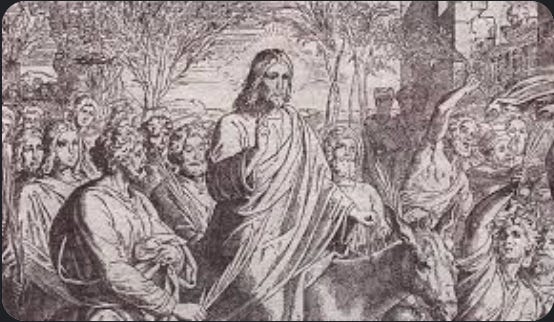I am in The Crowd
I am in The Crowd on Palm Sunday anticipating the arrival of The Messiah. What exactly am I anticipating? What is my image of God? Some in The Crowd are anticipating a vengeful God who would smite Israel’s enemies and turn them to stone. Some in The Crowd are anticipating a triumphant God who would bring about a new time of peace and harmony for the whole world. Some in The Crowd are anticipating a just God who would return the world to its original natural order. None knew what to make of the man on the mule. What was shattered on Palm Sunday, and what set the passion in motion was the destruction of peoples false images of God.
One of the great prisons in which we live is our own image of God. This is a well fortified prison whose walls are built with many types of bricks. These are lies we have convinced ourselves are not only true, but sacred. These bricks can be both personal and cultural. This collection of lies turned to bricks function like Russian dolls, one nested inside the other. Personal lies believed and our cultural lies consumed are intertwined. They build a wall that needs to be shattered. When we live our lives behind this wall, we believe is sacred, we have eyes that can not see and ears that can not hear.
To understand the wall you need to understand the bricks, the mortar and the foundation. I will describe this wall from the bottom up. The foundation on which this wall is built is the cultural worldview into which we are born. A child born in Japan has a grounding in a very different view of the world, than a child born in Rwanda, or a child born in the United States. This cultural worldview shapes so many elements of how we see the world. For our purposes here I will use the concept of Totem and Taboo. In short a Totem is a cultural aspiration and a Taboo is a cultural prohibition. These two are bound to each other by a system of power. This trinity forms what I will call a principality, or a cult. Culture is just the dominant cult.
The system of power concept needs to be understood first. In Japan you have an Empire, in Rwanda a tribe and in the United States you have a republic. These have very similar external facing functions. They negotiate with other cultures. They conflict with other cultures. They behave as one thing. However they are different in terms of internal function. These internal functions have similarities, but they have an incredible depth of difference.
The principalities have similar Totems. They aspire to female and masculine archetypical roles. They have the function of family. They have a pathway to success and cost for failure. They have Taboos. Things you are forbidden to do. These include marriage and sexual norms and prohibitions, means of financial exchange, and various means of social exchange. The balance of these totems and taboos in unison with the system of power keep the principality functioning. To better understand the depth of this process you need to understand the mortar. Myth and Ritual combine to form the mortar that holds the elements of the principality together. This keeps the system functioning. This keeps the process in motion.
Myth are the justifying stories told in the culture. They include a founding myth, how the principality was brought into being. They include justifying myths that talk to the origin and meaning of the Totems and Taboos. Finally they have a destination myth, what is the quest of the principality.
Rituals are the ceremonies and actions that breathe life into the principality. Rituals that engage the Totem include initiation rituals, rights of passage rituals and finally rituals of death that celebrate a life well lived and the individual is honored by the principality. Rituals that engage the Taboo include feasts, where the taboos are suspended in a family. Carnivals were the Taboos are played with and suspended at a cultural level and finally rituals of excommunication where the individual is reject by the principality.
Finally we come to the bricks. The cultural bricks are the lies at the heart of our myths. The personal bricks are the lies we have believed about our self. The combination of bricks and mortar on a cultural foundation form a false view of the world. A view that feels so true we can breathe it, and when it collapses we feel lost.
This is what happens on Palm Sunday. I believe the people in Jerusalem knew Jesus was the Messiah. The issue they had was accepting him when he did not fit their false image of God. This is why the passion is an Apocalypse, which means to pull the curtain back. The false world they live in had been called into question by the confusing entry of the man on the mule.



Thank you for your insightful, challenging message!
The most seductively dangerous idolatry is to make Jesus into our own image and likeness. We worship the false image and we will fight furiously to defend our idol we make of Jesus. It may take our prayers and the prayers of others that God will hear and crush the idolatry. May we all worship Jesus in Spirit and in truth.